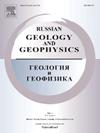C, O, and Sr Isotope Compositions of Belemnites from the Bajocian–Bathonian of Arctic Siberia: Implications for Global Correlations and Paleogeographic Reconstructions
IF 1
4区 地球科学
Q3 GEOSCIENCES, MULTIDISCIPLINARY
引用次数: 1
Abstract
–The Middle Jurassic sedimentary strata of Siberia remain poorly studied chemostratigraphically. We contribute to the knowledge with pioneering C, O, and Sr isotopic data for carbonate material of belemnites from the Yuryung-Tumus Peninsula and the lower reaches of the Lena River, as a basis for comprehensive description of the north Siberian Bajocian and lower Bathonian. The obtained chemostratigraphic constraints, with new 87Sr/86Sr ratios and previous δ13C and δ18O estimates, also include data for the lower Bathonian in the Sokur section (Central Russia). Despite the limited amount of material, chemostratigraphy, along with the available biostratigraphic data, allows reliable correlation of the Boreal sections with the primary standard of Northwest Europe, which is impossible for these strata with any of the two methods alone. The δ13C, δ18О, and 87Sr/86Sr patterns correlate with the records of eustatic, climatic, tectonic, and paleogeographic events. The new δ18O data and the inferred paleotemperatures for the latest early Bajocian and the Bajocian/Bathonian boundary reveal two excursions of notable seawater warming near the Siberian Arctic coast, which were synchronous with episodes of global sealevel rise. It was presumably during the eustatic events that the N–S Komi Strait (first naming) opened twice in the territory of the Russian Plate. The strait connected the Boreal and Tethyan seas and thus changed the oceanic circulation patterns. Specifically, it opened a gateway for a warm current from the south to northern Siberia responsible for the high seawater temperatures recorded in the δ18О patterns of belemnites.C、 北极西伯利亚巴焦阶-巴通阶贝伦岩的O、Sr同位素组成:对全球对比和古地理重建的启示
西伯利亚中侏罗世沉积地层的化学地层学研究仍然很少。通过对玉陵—图木斯半岛及勒拿河下游菱辉石碳酸盐物质的C、O、Sr同位素数据的研究,为全面描述北西伯利亚巴约世和下巴统提供了基础。根据新的87Sr/86Sr比值和以前的δ13C和δ18O估计,得到的化学地层约束也包括俄罗斯中部Sokur剖面下Bathonian的数据。尽管材料数量有限,化学地层学以及现有的生物地层学数据,可以将北纬剖面与西北欧的主要标准进行可靠的对比,这是单独使用两种方法中的任何一种都不可能实现的。δ13C、δ18О和87Sr/86Sr模式与海平面上升、气候、构造和古地理事件相关。最新的δ18O数据和推断的巴约纪晚期和巴约纪/Bathonian边界的古温度表明,在西伯利亚北极海岸附近有两次显著的海水增温偏移,与全球海平面上升的事件同步。据推测,在这次活动期间,南北向科米海峡(首次命名)在俄罗斯板块的领土上打开了两次。该海峡连接了北方海和特提斯海,从而改变了海洋环流模式。具体来说,它为从西伯利亚南部到北部的暖流打开了一个门户,导致了在δ18О菱铁矿模式中记录的高海水温度。
本文章由计算机程序翻译,如有差异,请以英文原文为准。
求助全文
约1分钟内获得全文
求助全文
来源期刊

Russian Geology and Geophysics
地学-地球科学综合
CiteScore
2.00
自引率
18.20%
发文量
95
审稿时长
4-8 weeks
期刊介绍:
The journal publishes original reports of theoretical and methodological nature in the fields of geology, geophysics, and geochemistry, which contain data on composition and structure of the Earth''s crust and mantle, describes processes of formation and general regularities of commercial mineral occurrences, investigations on development and application of geological-geophysical methods for their revealing. As to works of regional nature, accelerated publication are available for original papers on a variety of problems of comparative geology taking into account specific character of Siberia, adjacent Asian countries and water areas. The journal will also publish reviews, critical articles, chronicle of the most important scientific events, and advertisements.
 求助内容:
求助内容: 应助结果提醒方式:
应助结果提醒方式:


